Having a cold or flu can wreak havoc on your body, but it can also affect your dental health. This is especially true if you have recently had dental work. Fortunately, incorporating a few tips and tricks into your dental hygiene routine can reduce your chances of having oral health problems during or after having a cold or the flu.
Cold and flu season typically starts in October and can run as late as May, according to the Centers for Disease Control and Prevention (CDC), although you can catch a cold or the flu at any time of year. Furthermore, the CDC says that adults in the United States have an average of three colds per year and children have even more colds.
The signs and symptoms of a cold or flu virus can affect dental health in a variety of ways. Congestion in the sinuses can cause tooth pain, for example, as your upper rear teeth sit close to your sinuses. Additionally, excess mucus from postnasal drip can cause bad breath.
Colds and the flu can also cause dry mouth, as can the decongestants and other medications that are used to treat symptoms. Your mouth relies on saliva to keep oral tissues moist and to rinse away the bacteria that cause tooth decay. Nasal congestion and stuffy nose can cause you to breathe through your mouth, which can dry up your saliva and lead to a condition known as dry mouth.
Fever and sweating can cause dehydration which can also cause dry mouth, and a sore throat can prevent you from drinking enough fluids to stay hydrated. Without enough saliva to rinse it away, plaque-causing bacteria can build up to increase your risk of tooth decay.
Caring for your teeth and oral health is always important, of course, but especially when you have a cold or the flu. Here are seven ways to keep your teeth and gums healthy this cold and flu season.
1. BRUSH AND FLOSS YOUR TEETH WELL
Brushing and flossing are always essential for healthy teeth and gums, of course, but they are especially important when you have dry mouth from a cold or the flu. Remember to spend at least two minutes brushing twice a day, and to do a thorough job of flossing once daily.
2. STAY HYDRATED
Drinking plenty of fluids is especially important when you have a cold or the flu. If a sore throat or vomiting prevents you from drinking fluids, try taking sips of water or sucking on ice chips. Also, switch to water, juice, and soup as soon as you can.
3. GARGLE WITH SALTWATER
Gargling with saltwater can help relieve a sore throat, reduce the effects of bad breath and plaque, and cut down on the harmful bacteria that causes tooth and gum problems.
4. OPT FOR SUGAR-FREE MEDICATIONS
Many cold and flu medications contain sugar that improves their taste, but this sugar can feed the bacteria that cause tooth decay and gum disease. Look for over-the-counter cold and flu medications that contain sugar substitutes, such as xylitol or sucralose.
5. CONTINUE TAKING NASAL DECONGESTANTS
While nasal decongestants can cause temporary dry mouth, they actually relieve dry mouth in the long-run by clearing up your stuffy nose so that you can breathe again. Sitting in a small bathroom while a hot shower runs, using a room humidifier, and saline nasal spray can also open up your sinuses to make breathing through your nose easier.
6. SUCK ON COUGH DROPS OR SUGAR-FREE HARD CANDY
Cough drops and hard candy stimulate the flow of saliva to rinse away plaque and bacteria.
7. REPLACE YOUR TOOTHBRUSH WHEN YOU FEEL BETTER
Your old toothbrush may harbor the bacteria that caused your illness in the first place. Tossing your old toothbrush helps prevent re-infection with the cold or flu bug.
For more information on oral health tips for cold and flu season, consult with your dentist at Imagine Dentistry. The more you know about caring for your teeth and gums when you are sick will help you avoid dental problems throughout the rest of the year.









